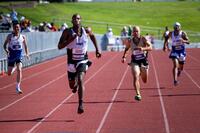When it comes to deciding what to do for a workout, many resort to magazine articles, website posts, social media memes, books or recall "what they used to do" in their teens. Regardless of your age, goals and fitness levels, there are many elements to consider when creating a workout program for yourself or following a trainer or program developed by trainers.
The Goldilocks of fitness: Too much, not enough, just right
Typically, during a fitness journey, there is a "hit-or-miss" phase that occurs as you figure out whether a program is working for you. One way not to see results of a program is to skip days of training or adjust the intensity so much that it is too easy (not enough work).
Another way is to add so much activity and intensity to a program that you overdo it and either become so sore or injured or completely burn out in a few days/weeks (too much, too soon). There is also that realization that you dialed it in perfectly, and you see a steady progression toward your goals (weight loss, faster run times, more reps, bigger muscles). No program works for everyone the same way.
Even personalized training programs will have a phase of finding what works best for you as an individual. Generic programs can work for you. However, as with all programs, you need to follow these steps to help you get the results you seek:
1. Consistency daily effort/habit. Without consistency, even the most perfectly designed fitness program will not work. Putting in the time, doing the workouts even when you do not feel like it and building solid habits that get you training more is the most important aspect to this journey. Even if your daily training is just walking for 30 minutes, only your consistency will yield results. Get moving and keep moving.
2. Are your goals weight loss? Many of us want to lose some weight, and some need to lose weight to actually have healthy symptoms in annual blood work/physical tests. One way to do that is to realize it is rather difficult to outwork your diet. Unless you are a highly active teenager or are in your early 20s, this wonderful time of being able to eat anything and as much as you want is not a reality as you age.
One of the best ways to start seeing progress is to work toward a caloric deficit, with a significant reduction in sugar. Do not eliminate any macronutrients (carbs, protein, fat). Unless you are diabetic/pre-diabetic, carbs (fruit/vegetable) should be major part of your diet, along with protein/fat.
3. Program selection. Are you picking out a program that fits your goals? Many books and training programs offer specific goals after completion. If the goals are performance driven (faster run, swim, more PT, PT tests, weight loss, weight gain), there is very little gray area to your improvement, and the results of your efforts can be measured objectively. If the goals are more aesthetic in nature (more muscle, less fat, look better, etc.), these results can be measured but are purely subjective and more focused on opinion versus fact.
4. Perfect balance ideas. It is easy to overdo it and get too aggressive during the first week of a training program. It is also easy to get into a low-intensity groove for too long and quit seeing results. Instead of doing something that is challenging you constantly on back-to-back days, perhaps do something that is a little more intense every other day, with easier mobility, non-impact cardio and flexibility days in between.
This is a perfect balance between too hard and too easy programming that offers the body time to recover, grow and see results. Make sure your routine has rest/recovery and mobility built in or at least suggested on "days off."
5. Accountability. Finally, when the days get too long and the mornings too early, you need to have a way to hold yourself accountable. Having a workout partner or someone who expects to see you helps with consistency over the long term. Maybe go to a workout class and have a coach/class be your reason not to miss. If it is not on the schedule, it does not exist, and a workout is easy to move around so much in a day that it is dropped because life gets in the way.
Stew Smith is a former Navy SEAL and fitness author certified as a Strength and Conditioning Specialist (CSCS) with the National Strength and Conditioning Association. Visit his Fitness eBook store if you're looking to start a workout program to create a healthy lifestyle. Send your fitness questions to stew@stewsmith.com.
Want to Learn More About Military Life?
Whether you're thinking of joining the military, looking for fitness and basic training tips, or keeping up with military life and benefits, Military.com has you covered. Subscribe to Military.com to have military news, updates and resources delivered directly to your inbox.


















